Burden of disease due to dementia among First Nations people
Burden of disease is a measure of the combined impact of living with illness and injury (non-fatal burden) and dying prematurely (fatal burden). Combined, this is referred to as the total burden, measured using disability-adjusted life years (DALY) – one DALY is equivalent to one year of healthy life lost. Burden of disease analysis allows for comparisons of all diseases, illnesses and injuries, by considering not only the number of people affected, but also the severity and duration of illness, and the age at death for fatal conditions.
The Australian Burden of Disease Study: impact and causes of illness and death in Aboriginal and Torres Strait Islander people 2018 provides the most recent estimates of disease burden among First Nations people.
Dementia was the 19th leading cause of disease burden among First Nations people in 2018
In 2018, dementia was the 19th overall leading cause of burden of disease among First Nations people. Dementia was responsible for just under 3,300 healthy years of life lost (DALY), 1.4% of the total burden experienced by First Nations people in 2018 (AIHW 2022). Women experienced over half (56%) of the total burden due to dementia among First Nations people.
The rate of burden due to dementia among First Nations people was over twice as high as the rate among non-Indigenous Australians (age-standardised rates of 13.0 and 6.1 DALY per 1,000 people, respectively).
Age is the biggest risk factor for dementia, and dementia’s ranking as a leading contributor to disease burden increased with age. Dementia was the leading cause of disease burden for First Nations people aged 75 and over. This was partially due to the high disease burden among women in older ages. For First Nations men aged 75–79, dementia was the third leading cause of disease burden, whereas among First Nations women aged 75–79, dementia was the leading cause (Figure 12.4).
Figure 12.4: Leading 10 causes of disease burden (DALY) among First Nations people in 2018, by sex and age
Figure 12.4 is a bar graph showing the leading 10 causes of disease burden (by number of disability-adjusted life years, DALY) among Indigenous Australians, by sex and age in 2018. Dementia was a higher ranked cause of disease burden with increasing age; it was the leading cause of disease burden among all Indigenous Australians aged 80 and over, and the leading cause of disease burden among Indigenous women aged 75 and over.
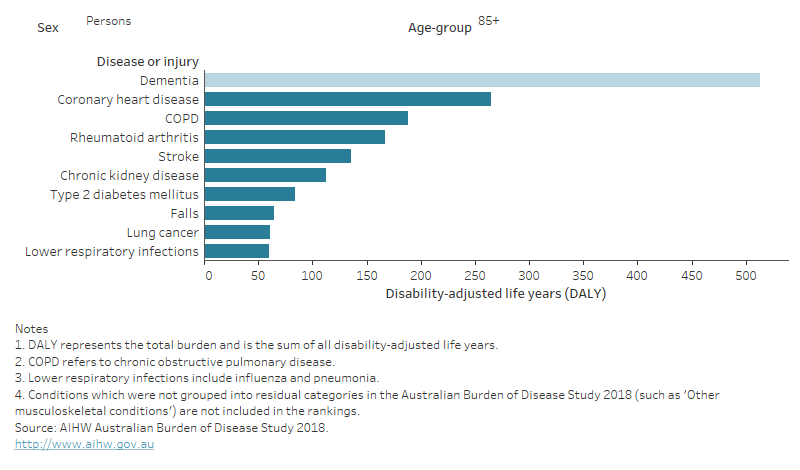
YLL, YLD and DALY
The fatal burden, or years of life lost (YLL), is measured against an ideal life expectancy (AIHW 2022). Fatal burden for dementia was calculated based on deaths where dementia was recorded as the underlying cause of death. It does not include deaths where dementia was an associated cause of death (see Dying due to dementia compared to dying with dementia for more information).
Years lived with disability (YLD) is measured as years living in poor health and is weighted by severity of disease to consider different impacts of different diseases. The total DALY is equal to YLL plus YLD.
In 2018, 62% of the burden due to dementia among First Nations people was due to years lived with disability (YLD) and 38% was from dying prematurely (YLL). This was similar for both men (64% YLD, 36% YLL) and women (61% YLD, 39% YLL) (Table S12.10).
This differs to the burden of disease due to dementia among non-Indigenous Australians which was mostly due to years of life lost (56% of DALY). There was also greater variation between men (YLL accounted for 62% of DALY) and women (YLL accounted for 53% of DALY).
Among First Nations people, the rate of burden of disease due to dementia (DALY per 1,000 people) increased gradually with age until 75–79 years, and then sharply increased in the 80–84 and 85 and over groups, mainly due to higher numbers of years of life lost (YLL) in those older age groups (Figure 12.5).
Figure 12.5: Dementia burden among First Nations people in 2011 and 2018: number (YLL, YLD) and age-specific rate (DALY per 1,000 people), by sex and age
Figure 12.5 is a stacked bar graph showing the number of years of life lost and years lived with disability due to dementia by age (which added together equal to disability-adjusted life years, or DALY) and a line graph showing the age-specific dementia DALY rate, amongst Indigenous Australians, by sex and year (2011 and 2018). It shows that the number of years of life lost and years lived with disability due to dementia were highest by number in Indigenous Australians aged 45–64. Years of life lost due to dementia became an increasing cause of the disease burden due to dementia with increasing age. The rate of DALY due to dementia increased with increasing age and was highest among people aged 85 and over. Overall patterns were similar for each year presented.
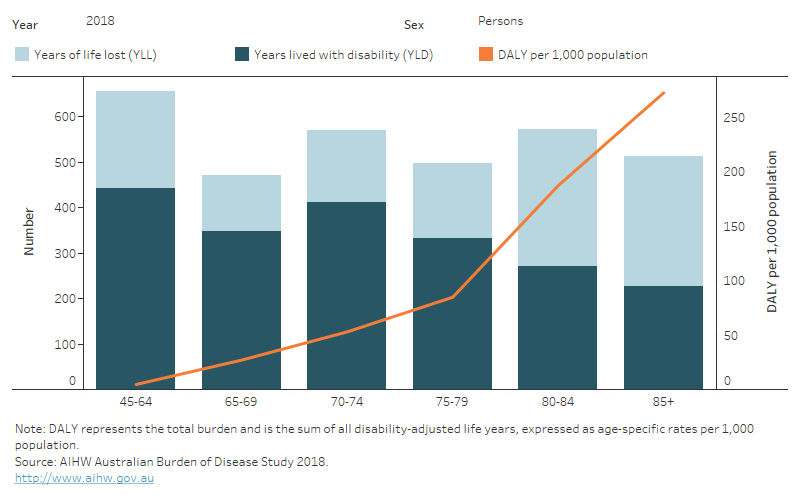
Burden due to dementia among First Nations people increased between 2011 and 2018
There was a slight increase in the age-standardised rate of burden due to dementia among First Nations people between 2011 and 2018, from 12.4 to 13.0 DALY per 1,000 people. This was due to an increase in the rate of fatal burden (from 5.2 to 5.6 YLL per 1,000 people), while the rate of non-fatal burden remained relatively stable between 2011 and 2018 (7.3 and 7.4 YLD per 1,000 people, respectively) (Figure 12.6).
Figure 12.6 : Dementia burden among First Nations people in 2011 and 2018: age-standardised YLL, YLD and DALY per 1,000 people, by sex
Figure 12.6 is a bar graph showing the age-standardised rate of years of life lost, years lived with disability and disability-adjusted life years due to dementia among Indigenous Australians in 2011 and 2018 by sex. There was a slight increase in the rate of disability-adjusted life years due to dementia between 2011 and 2018, mainly due to an increase in the rate of years of life lost due to dementia.
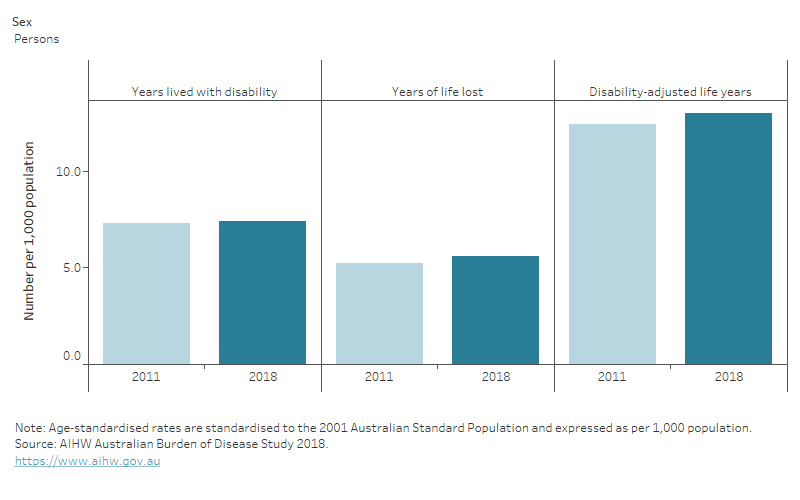
Dementia burden among First Nations people attributable to risk factors
Disease burden due to risk factors is known as the attributable burden. It is measured as the number of healthy years of life lost that could have been avoided if exposure to the risk factor had been reduced or completely avoided.
The Australian Burden of Disease Study (ABDS) 2018 estimated the dementia burden attributable to 6 modifiable risk factors, including:
- tobacco use
- overweight (including obesity)
- physical inactivity
- high blood pressure
- high blood plasma glucose
- impaired kidney function.
Note, this is not an exhaustive list of risk factors linked to dementia (for example, low education levels – an established risk factor for dementia – is not included) and only includes risk factors measured in the ABDS 2018. The list of risk factors and measures of additional risk (relative risks) were based on those used in recent Global Burden of Disease studies and a number of epidemiological studies. Refer to What puts someone at risk of developing dementia? for more information on the complete list of established risk factors for dementia.
53% of the dementia burden among First Nations people was attributable to 6 risk factors combined
Overall, 53% of the dementia burden in 2018 was attributable to the 6 risk factors combined (Table S12.12). This estimate takes into account the complex pathways and interactions between risk factors, such as the relationship between physical inactivity, overweight (including obesity) and high blood pressure. However, this work does not incorporate the impact of age as a separate risk factor for dementia. Age is the main risk factor for dementia but because it is not a modifiable risk factor, it is not included in burden of disease studies.
Of the 6 risk factors, overweight (including obesity) contributed the most to dementia burden among First Nations people (19%), followed by high blood plasma glucose (11%) and physical inactivity (9%). These leading 3 risk factors were consistent across men and women.
The proportions of burden attributable to overweight (including obesity) and physical inactivity were higher among women compared to men. While the proportions of burden attributable to tobacco use, impaired kidney function and high blood pressure were higher among men compared to women (Figure 12.7).
Figure 12.7: Joint effect of risk factors contributing to dementia burden among First Nations people in 2018: DALY, YLD and YLL (proportion of total dementia burden), by sex
Figure 12.7 is a bar graph showing the percentage of years of life lost, years lived with disability and disability-adjusted life years (DALY) due to dementia that were attributable to specific risk factors among Indigenous Australians by sex in 2018. Risk factors include tobacco use, overweight (including obesity), physical inactivity, high blood pressure, high blood plasma glucose and impaired kidney function. Overall, overweight (including obesity) was the greatest contributor to disability-adjusted life years due to dementia, followed by high blood plasma glucose and physical inactivity. The proportion of dementia DALY attributable to overweight (including obesity) and physical inactivity were higher in women compared to men, while the proportion of dementia DALY attributable to tobacco use, impaired kidney function and high blood pressure were higher in men compared to women.
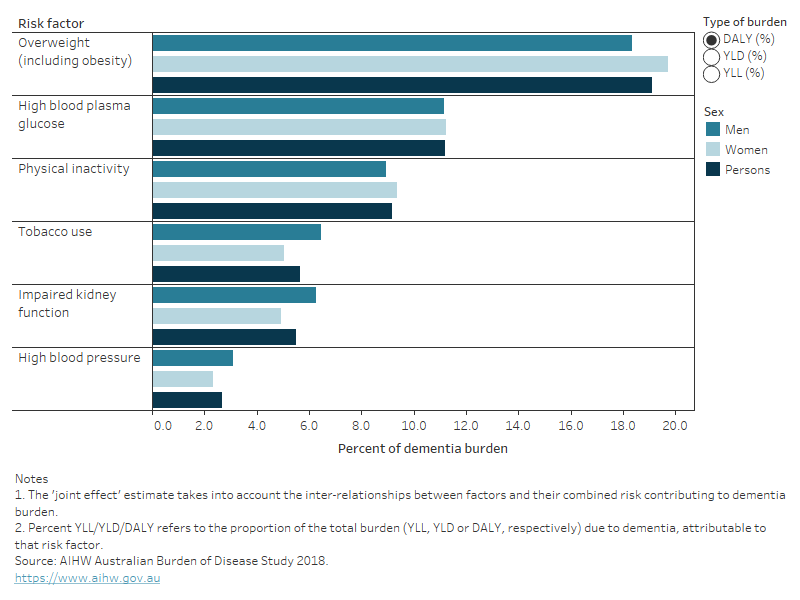
How do risk factors impact dementia burden among First Nations people by age?
The amount of dementia burden attributable to each of the 6 linked risk factors varied by age. This is due to age differences in both exposure to the risk factor, as well as the burden of dementia by age. The attributable dementia burden was greatest in First Nations people aged 75 and over (Figure 12.8).
In 2018, dementia burden attributable to tobacco use was slightly higher in First Nations people aged 45–64 (78 DALY) compared to those aged 65–74 (75 DALY). Dementia burden attributable to tobacco use was highest in First Nations people aged 75 and over (88 DALY).
For the other 5 risk factors – overweight (including obesity), high blood plasma glucose, physical inactivity, impaired kidney function and high blood pressure – dementia burden attributable to each factor increased with age.
Between 2011 and 2018, there was little difference across age groups in changes to the proportion of dementia burden attributable to overweight (including obesity), physical inactivity, high blood pressure and high blood plasma glucose. However, the proportion of burden due to tobacco use decreased in First Nations people aged 65-74 and 75 and over between 2011 and 2018, and the proportion of burden attributable to impaired kidney function increased for First Nations people aged 75 and over.
Figure 12.8: Dementia burden among First Nations people attributable to specific risk factors in 2011 and 2018: YLL, YLD and DALY, by sex and age
Figure 12.8 is a bar graph showing the number of years of life lost, years lived with disability and disability-adjusted life years (DALY) due to dementia that were attributable to specific risk factors among Indigenous Australians by sex and age in 2011 and 2018. Risk factors include tobacco use, overweight (including obesity), physical inactivity, high blood pressure, high blood plasma glucose and impaired kidney function. The dementia DALY attributable to each risk factor increased with increasing age and was greatest among those aged 75 or over.
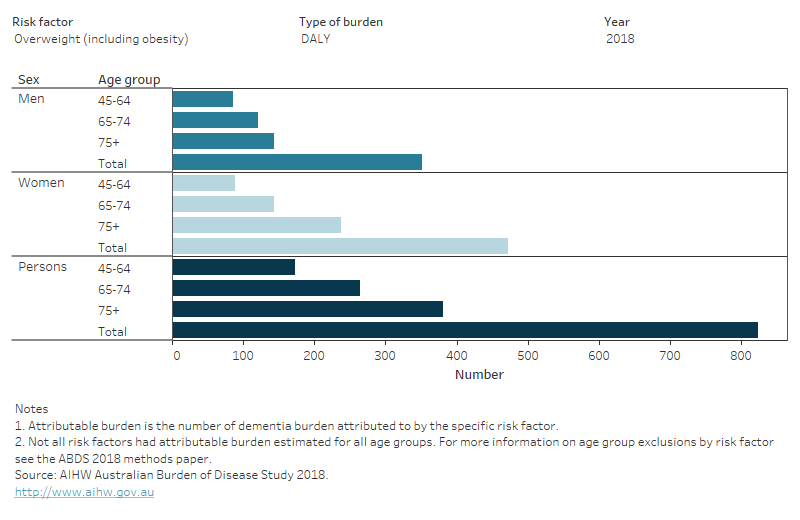
AIHW (Australian Institute of Health and Welfare) (2022) The Australian Burden of Disease Study: impact and causes of illness and death in Aboriginal and Torres Strait Islander people 2018, AIHW, Australian Government, accessed 3 May 2022.


